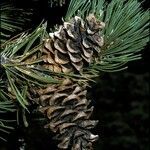A soft pine. It can be 12 m high and the trunk 60 cm across. The tree can spread 6 m wide. The bark is smooth and pale grey when young. It becomes rough, dark brown and with wide scaly plates with age. The leaves are in clusters of 5. The needles remain on the tree for 5-6 years. The cones are narrowly oval and are 8-20 cm long. They have very short stalks and are at right angles to the stem. There are 40-70 scales which are slightly thickened at the tip. They are spoon shaped without prickles. They open on the tree at maturity to release the seeds. The cones are shed during winter.








